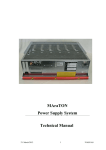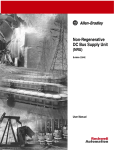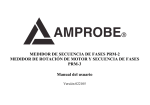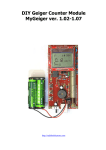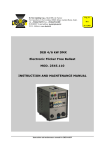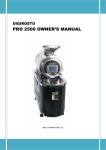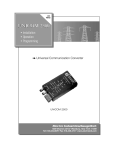Download PRM-2 and PRM-3 Phase Sequence Testers Product
Transcript
PRM-2 PHASE SEQUENCE TESTER PRM-3 PHASE SEQUENCE & MOTOR ROTATION TESTER User’s Manual Version 022105 CONTENTS PRM-2 & PRM-3 1. Warranty…………………………………………………………….....3 2. Safety precautions and procedures………………………………….....4 3. Introduction…………………………………………………………....5 PRM-2 PHASE SEQUENCE TESTER 4.1 During Use………………………………………………………….....7 4.2 Features…………………………………………………………….….9 4.3 Cleaning and maintenance………………………………………..…...9 4.4 Recycling………………………………………………………….....10 4.5 Technical data……………………………………………………..…10 PRM-3 PHASE SEQUENCE & MOTOR ROTATION TESTER 5.1 During Use…………………………………………………………..11 5.2 Features……………………………………………………………...14 5.3 Cleaning and maintenance………………………………………..…14 5.4 Recycling…………………………………………………………....15 5.5 Technical data…………………………………………………….....15 2 1. Warranty (PRM-2 & PRM-3) Congratulations! Your new instrument has been quality crafted according to quality standards and contains quality components and workmanship. It has been inspected for proper operation of all of its functions and tested by qualified factory technicians according to the long-established standards of our company. Your instrument has a limited warranty against defective materials and/or workmanship for one year from the date of purchase provided that, in the opinion of the factory, the instrument has not been tampered with or taken apart. Should your instrument fail due to defective materials, and/or workmanship during this one year period, a no charge repair or replacement will be made to the original purchaser. Please have your dated bill of sale, which must identify the instrument model number and serial number and call the number listed below: AMPROBE / Repair Department Phone: 954-499-5400 • Toll Free: 800-327-5060 • Fax: 866-287-7222 Website: www.Amprobe.com Please obtain an RMA number before returning product for repair. Outside the U.S.A. the local representative will assist you. Above limited warranty covers repair and replacement of instrument only and no other obligation is stated or implied. 3 2. Safety Precautions and Procedures (PRM-2 & PRM-3) This tester conforms to the safety standard EN 61010-1, relating to the electronic measuring instruments. For your own safety and that of the instrument, you must follow the procedures described in this operation manual and especially read carefully all the notes proceeded by the symbol . WARNING • • • • • • 4 Do not test any circuits in the extremely humid or wet environment. After transferring the tester from a cold place into a warm one, please, wait about 30 min. to get the tester acclimated to the present conditions. You can wipe the condensed dew, if necessary. Do not operate the meter in the environment with explosive gas (material), combustible gas (material), steam or filled with dust. Insulate yourself from the objects being measured. Do not make contact with any exposed metal (conductive) parts such as the tips of the test leads, sockets, fixing objects, circuits, etc. Do not conduct any measurements if the tester is defective, with the defective casing or test leads (breakages, deformations, fractures, contaminations, etc). The followings symbols are used: Caution: Please, refer to the operation manual. Incorrect use may damage the tester or its components. Meter double insulated. 3. Introduction (PRM-2 & PRM-3) • • • • • This instrument has been designed for use in the environment of the pollution degree 2. You must comply with the usual safety regulations aimed at: ® Protecting you against the dangerous electrical current. ® Protecting the instrument against an incorrect operation. Only the leads supplied with the instrument guarantee compliance with the safety standards. They must be in a good condition and they must be replaced, if necessary with the identical ones. Do not test or connect to any circuit with voltage exceeding the specified overload protection. Do not perform any measurement in the environmental conditions exceeding the specified limits. 5 WARNING The PRM-2 or PRM-3 tester can be operated only by the qualified persons having suitable authorization for performing work on electrical installations. Using the tester by the unauthorized people can cause damage to the instrument and be very dangerous for the user. WARNING The PRM-2 or PRM-3 tester is designed for tests of phase sequence in the three-phase line and three-phase motor rotations. All applications different from the given above may cause damage to the instrument and be a source of a serious danger for the user. 6 PRM-2 PHASE SEQUENCE TESTER 4.1 During Use (PRM-2) WARNING When the tester is connected to the measured circuits, never touch the tips of the unused test leads! WARNING Connecting the tester to the voltage exceeding 600V can damage the tester or cause danger for the user. • Connect the tester to the circuit under test. 7 ® ® ® • 8 Check for voltage on all phases: three LEDs marked “A”, “B” & “C” should be on. If there is a lack of voltage on one of the test leads the corresponding LED will not illuminate. If a voltage is pre- • • sent on one or two leads and the remaining leads are connected to neutral or ground, both or all LEDs will illuminate not including the phase sequence LEDs. If the voltages of all phases are correct it is possible to read out the phases’ order by observing the illumination of the LED marked as “NORMAL (ABC)” or “REVERSE”. After conducting a test, the instrument should be disconnected from the circuit under test. The tester left under voltage for long periods of time can overheat. In such a case the built-in thermal protection will disconnect the electronic system and the indications will be switched off. If such a situation occurs you should disconnect the tester from the installation and wait a few minutes before another use of the tester (the tester will run automatically after cooling down). 4.2 Features (PRM-2) • • • Indication of phase sequence in the wide range of power network voltages. Phase voltage drop indication: the tester indicates phase voltage losses and sags on one or two other phases by turning off corresponding LED: (A, B or C) and phase sequence indicator LED. Thermal protection of the tester (self-recovery thermal circuit breaker protects the tester from overheating, when left connected to a network for a long period of time). 4.3 Cleaning and Maintenance (PRM-2) The tester casing should be cleaned with a soft, wet flannel, using generally available deter- gents. Do no use any solvents, nor cleaning agents that could scratch the casing (powders, pastes, etc.). 9 4.4 Recycling (PRM-2) Testers in need of repair should be sent to the manufacturer. In the case of disposal the user is obliged to follow the local recycling regulations. 4.5 Technical Data (PRM-2) Inter phase voltage range .................................................................................... from 100 to 600V Operating frequency range ........................................................................................... 45 to 65 Hz Maximum phase to earth voltage ............................................................................................ 350V Power supply ......................................................................................... from the installation tested Current consumption (from the line voltage) ..................................................... max 3,5mA (385V) Storage temperature ………......................................................................... –25..+60°C (<80%RH) Operation temperature ………...................................................................... –10..+45°C (<70%RH) Insulation ........................................................... double, according to EN 61010-1 and IEC-61557 Measurement category ................................................................ CAT III 600V as per EN 61010-1 Casing protection class per EN 60529 ..................................................................................... IP40 Compatible with standard…………….…………….........…………………...............……IEC 61557-7 Dimensions (without cables) .................................5.47” (139 mm) x 2.68” (68 mm) x 1.26” (32mm) Weight (with cables) ..........................................................................................ca. 7.05 oz. (0,2 kg) 10 PRM-3 PHASE SEQUENCE & MOTOR ROTATION TESTER 5.1 During Use (PRM-3) WARNING When the tester is connected to the measured circuits, never touch the tips of the unused test leads. WARNING Connecting the tester to the voltage exceeding 600V can damage the tester or cause danger for the user. PHASE SEQUENCE TEST • • Connect the tester to the examined installation with the use of the test leads. Turn on the tester with the ON/OFF key. 11 ® ® ® (PRM-3) 12 • • • Check the voltage presence of all phases: The LED marked as PHASE LOSS should be off. The lack of voltage or connection of one of the leads to the circuit’s “N’ or “GND” will cause the LED to turn off. If the voltages of all phases are correct it is possible to read out the phases’ order by observing the illumination of the LEDs marked “NORMAL (ABC)” or “REVERSE”. After conducting a test the instrument should be disconnected from the circuit. MOTOR ROTATION TEST • ® • Connect the tester to the motor with the use of the test leads (the motor must be disconnected from the power line). Turn on the tester with the ON/OFF key. • • • Turn the rotor in the desired direction. If the LED labeled NORMAL (ABC) illuminates, it indicates that the phases are in accordance with electrical standards. If the LED labeled REVERSE illuminates, it indicates that two phases are reversed. When the LED labeled NORMAL (ABC) illuminates, mark the phases as accordant with electrical standards. After conducting a test, the tester should be turned off and disconnected from the motor. When three-phase line is in the desired order, the motor will turn in the desired direction. 13 Attention: The LED marked as PHASE LOSS will most likely be illuminated during the motor test. The lamp indicates that the voltage is below 20Vac. 5.2 Features (PRM-3) • • • • Indication of phase sequence in the wide range of power network voltages. Phase voltage loss or sag: the tester indicates phase voltage loss or sag by illuminating the LED labeled PHASE LOSS. Indicates three-phase motor rotation. Low Battery Indication: the tester indicates when its power supply battery should be replaced by illuminating its LOW BATTERY LED. 5.3 Cleaning and Maintenance (PRM-3) The tester’s casing can be cleaned with soft, damp flannel using commonly available detergents. Any solvents or cleaners that could scratch or blemish the housing (such as powders, pastes) should not be used. 14 5.4 Recycling (PRM-3) Testers in need of repair should be sent to the manufacturer. In the case of disposal the user is obliged to follow the local recycling regulations. 5.5 Technical Data (PRM-3) • • • • • • • • • • • Inter phase voltage range……............................................................................................50..600V Operating frequency range.................... ............................................................................45..65Hz Power supply….......................................................................9V alkaline battery (dimension 6F22) Storage temperature.........................................................................................-20..60°C (<80%RH) Operating temperature range..............................................................................0..40°C (<70%RH) Insulation...................................................... double, according to PN-EN 61010-1 and IEC 61557 Measurement category................................................................. CAT III 600V as per EN 61010-1 Housing protection class per PN-EN 60529 ………………....................................................... IP40 Conform with standard..................................................................................................IEC 61557-7 Dimensions (without wires)................................. 5.47” (139 mm) x 2.68” (68 mm) x 1.26” (32 mm) Weight (without battery).................................................................................... ca. 7.05 oz. (0,2 kg) 15 www.Amprobe.com 16
















